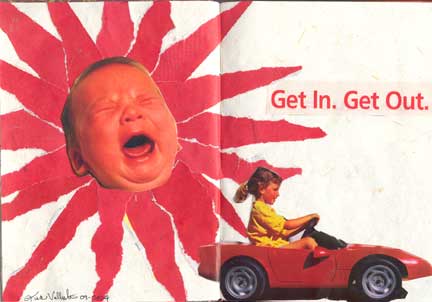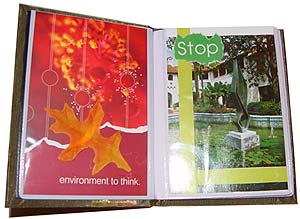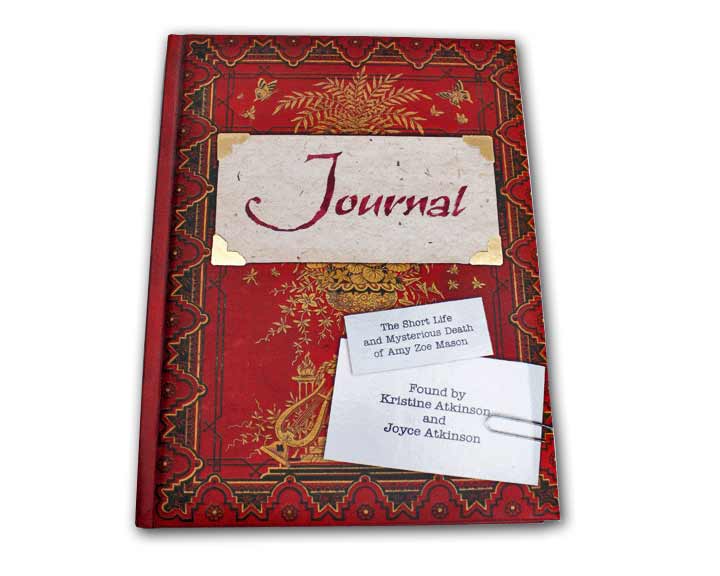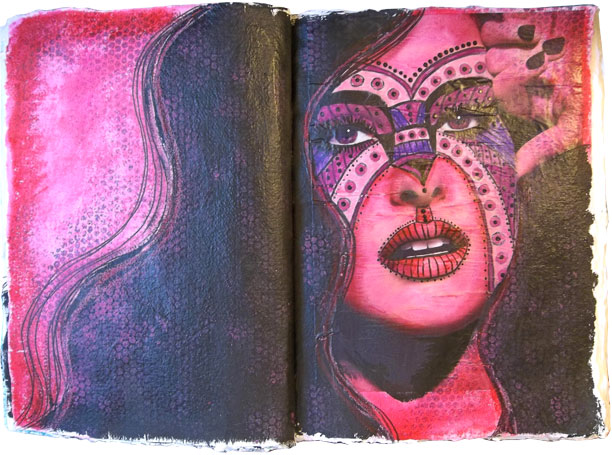In 2004, I wrote the first English-language article about gluebooks, titled Discovering Gluebooks. At the time, I thought I was just writing a quick piece about something interesting I found on a Dutch web site. Little did I know that that article would change my life.

What the Heck is a Gluebook?
A gluebook is a sort of collage journal, made by gluing everyday things into a book. The supplies required for gluebooking are very basic; all you need is a book, some glue, and something to glue into the book. For most gluebookers, that something is a combination of junk mail, magazine pages, and the paper ephemera they collect during the day.
At the time I discovered gluebooks, and started both writing about and creating them, I was working in the craft industry, in product development for a small arts and crafts publishing company. Part of my job was to search out new and interesting craft techniques that might spark the idea for new publications. Often, these were heavily focused on the products sold at national craft stores.
Gluebooks fascinated me for one simple reason: they are virtually product-free. There was no long supply list, or array of techniques required to start my first gluebook. At a time when many of the arts and crafts areas we wrote about were heavy on techniques and products, gluebooks stuck out like a sore thumb. There was no way to produce even the smallest book about them. They simply required no more than a few sentences of explanation.

Where I Glue, They Will Follow
One of the first things I did after writing Discovering Gluebooks was open a Yahoo! Group dedicated to gluebooking. The group quickly swelled to over 300 members, and has maintained that membership level ever since. There has always been a great deal of excitement among new group members, many of whom confess they’ve been gluebooking for years, but never knew there was a term for what they were doing. Members often express relief at the freedom gluebooks gives them from purchasing new products and learning new techniques. They are free to simply glue, and enjoy themselves
Although the Yahoo group still exists, it has fallen silent, except for daily prompts posted automatically by the group’s calendar.
In 2012, I opened a gluebook group on Facebook, hoping that some of the daily interaction that was no longer happening on the Yahoo! Group might be better served by social media. The group is somewhat quiet, but there is an occasional wave of photos posted. It’s a good place to ask questions, and see images of gluebooks from a variety of artists.

The Rules & the Glue Monkeys
As the gluebooks group quickly began filling with people looking for guidelines, I came up with this definitive, simple set of rules for gluebooking:
- Find a book. Any book. Spiral bound, blank, composition, used, old, new, whatever. It’s your gluebook.
- Find some glue. Any glue you like, because you’re the one who is going to use it.
- Find some things to glue. Any things you like, because you’re the one who will be gluing them.
- Glue with reckless abandon!
Shortly after the Yahoo group formed, member Kathleen Marie Pequignot posted a message that began “Good morning, glue monkeys!”, and the moniker stuck. Group members of both the Yahoo and Facebook groups sometimes call themselves glue monkeys.
Really. There Are No Rules.

This is one of my gluebook pages, with a little doodling added. Yes, you can doodle in your gluebooks. The art police absolutely will not come knocking at your door if you add arty elements that are not specifically glued.
I generally keep several gluebooks going at one time. I have one tucked into the drawer of the coffee table in the living room, and another on my computer table. That way, no matter where I am watching videos or TV, I have a book to work in close by.
Gluebooks FAQ
Here are the questions I’m most often asked about gluebooks…
What exactly is a gluebook?
A gluebook is a type of collage journal, created by gluing down everyday items such as magazine images, labels, tickets, cash register receipts, or whatever paper inspiration falls into the artist’s hands.
If I draw, paint or rubber stamp in my gluebook, is it still a gluebook?
The art police will not come to your door if you choose to use other media in your gluebook. Clearly, since it’s called a gluebook, the basis is that something is being glued. How it is embellished or augmented beyond that is up to each individual artist.
What kind of book should I use for my gluebook?
The answer to this is as varied as the artists who create gluebooks. Some folks are using blank spiral sketchbooks. Some prefer composition books. Others are using whatever blank journals they have at hand. Simply choose a book that is a comfortable size and shape for you, and dive in.
What techniques should I learn before starting my first gluebook?
There are no techniques required. Simply grab your favorite glue, and find something to glue down. Pull things from your newspapers, magazines, junk mail—-everything is gluebook fodder. This is the antithesis of almost every paper craft—there is nothing to learn. Just express yourself.
What’s the difference between gluebooks and altered books?
Gluebooks are basically a type of journal, and usually begin with some sort of blank book—however, if you choose to do your gluebook in a printed book, that’s your own creative choice. Unlike altered books, there are no techniques involved in gluebooks, and no basic supplies required other than some glue and something to be glued down. Which glue, and which things—those are all up to you.
A Gluebook Flip-Through
I’m working on getting all my gluebooks captured on video. This is the first gluebook I worked in, and one of the few that’s full from beginning to end:
Realigning My Creative Priorities
Prior to Discovering Gluebooks, I was very much focused on products. Each time a new product became popular in the mixed-media community, I had to find it and try it out. Since I spent the previous six years working at the corporate offices of the world’s largest craft chain, I had access to all sorts of products that weren’t widely available yet. My artwork became a sort of product testing ground for the craft industry. I didn’t spend a lot of time becoming proficient at any one thing, because there was always something new to try.
After I started working in gluebooks, my creative priorities changed. I became more interested in what I could do with just a few supplies, combining and recombining them in my work until I started to develop my own style. I took a big step forward in my work, as I focused on what I was making, rather than what I was making it with. I became more confident about presenting myself as an artist, rather than a writer of how-to articles and books.
With this change came a shift in my writing. Rather than writing about an endless stream of new products, I started focusing on techniques. I found great joy in developing articles, and eventually, classes, that used the same basic supplies in different ways. My students enjoyed the fact that once they bought a few supplies, they were set for an entire class.
You can see more of my gluebook work on my web site.




